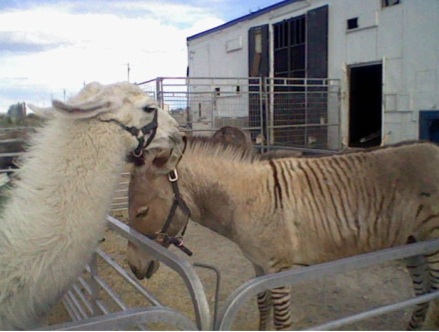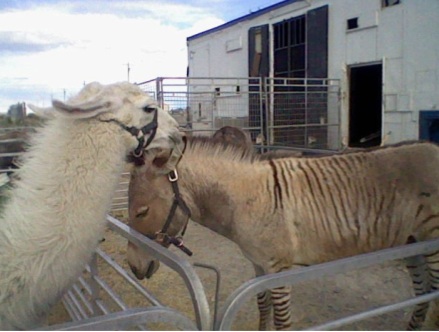[media id=13 width=320 height=240]
While high winds canceled the main event, circus go-ers did have their disappointment at least partially assuaged with the chance to see the Circus small collection of rare animals including a ‘zonkey’ a donkey zebra cross.
Zonkey and zorses (zebra/horse crosses) have been bred since the 19th century. The extinct quagga was also crossed with horses and donkeys. Charles Darwin noted several zebra hybrids in his works.
Most often the cross is the result of a zebra stallion and female donkey or mare. The reason for this one sided type of breeding is less due to genetics than it is to temperament of the zebra mare who is apparently a good deal more choosey apart her partners than a domesticated equine.
According to one blogger an attempted mating between a zebra mare and his prize Morgan stud stallion proved a disaster. Not only did the zebra mare refused to mate but the beating she gave to her would be suitor so traumatized the stallion that he never again attempted to mate with any other horse mare ever again.
“She kind of blew his confidence,” the author wrote.
While horses, donkeys and zebras have different numbers of chromosomes. A donkey has 62 chromosomes; the zebra has between 32 and 46 (depending on species). In spite of this difference, viable hybrids are possible, provided the gene combination in the hybrid allows for embryonic development to birth. A hybrid has a number of chromosomes somewhere in between. The chromosome difference makes female hybrids poorly fertile and male hybrids generally sterile due to a phenomenon called Haldane’s Rule. The difference in chromosome number is most likely due to horses having two longer chromosomes that contain similar gene content to four zebra chromosomes. Horses have 64 chromosomes, while most zebroids end up with 54 chromosomes.
Zebroids physically resemble their non zebra parent, but are striped like a zebra. The stripes generally do not cover the whole body, and might be confined to the legs or spread onto parts of the body or neck. If the non zebra parent was patterned (such as a roan, Appaloosa, Pinto horse, paint, piebald, or skew bald), this pattern might be passed down to the zebroid, in which case the stripes are usually confined to nonwhite areas. The alternative name golden zebra relates to the interaction of zebra striping and a horse’s bay or chestnut color to give a zebra-like black-on-bay or black-on-chestnut pattern that superficially resembles the quagga. In zebra-donkey hybrids, there is usually a dorsal (back) stripe and a ventral (belly) stripe.
Zebroids are preferred over zebra for practical uses, such as riding, because the zebra has a different body shape from a horse or donkey, and consequently it is difficult to find tack to fit a zebra. However, a zebroid is usually more inclined to be temperamental than a purebred horse and can be difficult to handle. Zebras, being wild animals, and not domesticated like horses and donkeys, pass on their wild animal traits to their offspring. Zebras, while not usually very large, are extremely strong and aggressive. Similarly, zorses have a strong temperament and can be aggressive.
In Origin of Species (1859), Charles Darwin mentioned four colored drawings of hybrids between the ass and zebra. He also wrote “In Lord Morton’s famous hybrid from a chestnut mare and male quagga, the hybrid, and even the pure offspring subsequently produced from the mare by a black Arabian sire, were much more plainly barred across the legs than is even the pure quagga.” In his book The Variation of Animals and Plants under Domestication, Darwin described a hybrid ass-zebra specimen in the British Museum as being dappled on its flanks. He also mentioned a “triple hybrid, from a bay mare, by a hybrid from a male ass and female zebra” displayed at London Zoo. This would have required the zebroid sire to be fertile.
In addition to the zonkey the menagerie contained a pygmy hippo, lamas, camels, pygmy goats and a pygmy humped cow from Asia.




